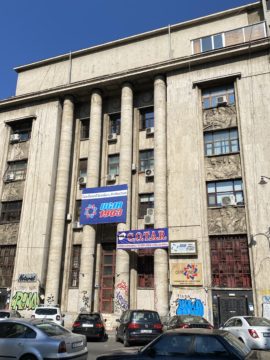From David Winner’s first column about his poignant relationship with buildings and their ornamentation, to Angela Starita’s discussion of the Bengali/Italian/Uzbek gardens of Kensington, Brooklyn as well her own growing up with her Italian-born father who became a farmer in middle-age, our column centers around place and what it signifies: architecturally, historically, emotionally. We will try to interrogate buildings: factories, apartments, houses, cities. Sometimes we will enter inside their doors to focus on what goes on inside.
by David Winner
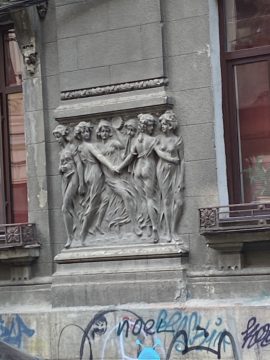
When Angela and I visited Paris for the first time in the early nineties, we stayed in a large house near the Parc Monceau owned by a friend of my great-aunt’s, Henri Louis de la Grange, Mahler scholar and bona fide baron. When Alain, a former lover of Henri Louis, had us to dinner one night, he complained about a recent visit to Cincinnati. Echoing Gertrude Stein’s famous “no there there,” comment, he dismissed the city as “provincial.” When I repeated the comment to Henri Louis later over dinner with my great-aunt, he disdained Alain, from Normandy, as provincial himself.
That memory begs two questions. What constitutes provincial, and where and what is “there?”
Many students at the community college where I teach come from former colonies of the Spanish empire. Provincial backwaters to some: think poor Zama in Antonio de Benedetto’s eponymous novel, stuck in murky Asuncion, desperate to get transferred to Buenos Aires. My students often refer to the capital city of their country not by its name – Santo Domingo, Quito, San Salvador – but simply as “the capital.” After moving to Jersey City within spitting distance of Manhattan, those cities remain capitals for them, the antitheses of provincial.
*
I visited Riga, the capital of Latvia, which spent much of its recent history as a backwater of the Russian then Soviet empires, in the summer of 1997 when Angela was doing a program for journalists in Finland. I took the ferry across the Baltic Sea to Estonia, then a bus to Riga. The Soviet Union had only recently fallen, and it felt like a distant, exotic destination. Except it wasn’t. The well-preserved Old Town with its late seventeenth century German architecture bustled with tourist life.
In search of someplace more remote, I followed a one-sentence description in my flimsy guide to the Baltics and headed off to Elizabetes iela, Elizabeth Street, known for art nouveau buildings that came up about two centuries after the structures in the Old Town. The short walk took me though dark, grubby streets past distant Soviet apartment buildings, eventually landing me in front of Elizabetes iela 1b. Notable buildings often have names – Falling Water, Villa Savoye – but the imposing, deteriorating structure designed by Mikhail Eisenstein, the father of the film director, is known only by its address. In a small way, that building changed my life.
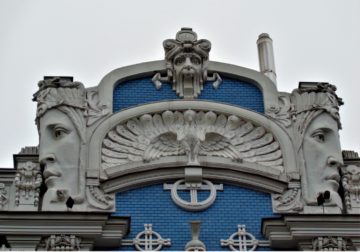
Wild, busy like the Milan Cathedral, but in a completely different style, the six huge floors burst with ornamental flourishes, but what struck me most were the huge faces on the top, more than four or five meters tall. Androgynous, expressionless, uncannily sad, they wear crowns on their heads. And have been nonchalantly greeting building inhabitants and passersby for nearly a century.
Almost every building for two long blocks was grandiose and in need of repair. I snapped picture after picture (the images now lost) until my single-use camera ran out. Very few people came in and out of the buildings. In their fifties and older (ancient seeming to me at the time), they carried food from the market, newspapers, cigarettes. As I regarded their rugged faces, I wondered about their relationships with the faces on the buildings, the ornamentation, the eccentric flourishes surrounding them. They seem defeated, deadened, while the structures surrounding them buzzed with life.
*
No building in which I have lived – and I am not unusual – has had anything like those faces in Riga. Few quirky details, no frilly embellishments, only wood or concrete or brick with which to build a relationship.
The closest thing was an old brass lion that my parents bought at an antiques store and placed on the side of the long porch of the house in which I grew up in Charlottesville. Just a little bit bigger than a large cat, an opaque expression had settled on his face. He stood guard for decades – though failing to prevent the house burglary in the nineties – until both my parents died, and the house was sold. I lost track of him in the chaotic last days during which the house was cleared of its objects. And I wonder where he is and if he ever thinks of me.
When “old Mr. Davis,” who lived in the grey house next door, died in the seventies, an art historian and a photographer, a gay couple, moved in. They radically renovated the house, so it began to resemble a funeral parlor and placed a huge replica of a Greek urn at the center of the circular driveway that they had constructed. Not long after it was put in place, a few neighborhood boys came over in the middle of the night and tried unsuccessfully to vandalize it. Queer bashing was their primary motivation, but I wonder if they felt offended by its ornamental nature, unlike almost anything in any of the neighboring houses except, of course, the brass lion.
*
A decade or so after Riga, Angela and I found ourselves in another provincial capital, Montevideo, rather by chance. We had visa problems in Brazil and flew to Uruguay, a country that did not require one.
On our first morning, we strolled around the grandest of Montevideo’s squares, the Plaza Independencia, and I wondered if its residents thought much about Uruguayan independence, which had been won about two hundred years before, or some more metaphoric sense of freedom or independence. I never thought of Charlotte, King George’s queen, while growing up in Charlottesville nor locusts growing up on Locust Avenue, but old queens and insects are not bold concepts like independence.
Many of the buildings around the square came up about the same time as the ones in Riga, but the most striking structure, the Palacio Salvo, was built later, 1928, as a hotel but immediately became an apartment building for the elite of Montevideo.
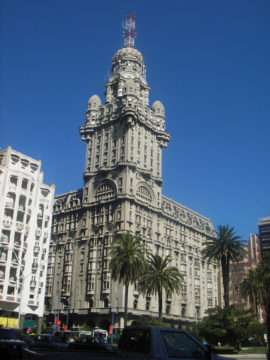
A madman’s folly, it was built by Mario Palanti, an Italian immigrant living in Buenos Aires. The very top was intended to be a lighthouse on land, as Samborombón Bay lies only a few blocks away. The plan got dropped, but at 330 feet, including the antenna on top, it was briefly the tallest building in South America.
At cafes and restaurants, we asked anyone who would talk to us what about Salvo. It was falling apart, we learned, many apartments uninhabitable. It reeked of urine and mold, was rat-infested and (about this almost everyone agreed) was seriously haunted.
I approached it a couple of times while we were in Montevideo, wondering how I could get inside its locked doors. It was curiosity, a kind of ghostly thrill seeking. Eventually, someone would emerge from it, but my Spanish wasn’t good enough to approach them with a desire that I didn’t understand myself.
*
Across the bay from Montevideo lies a city with Parisian (Haussmannian) boulevards and squares, enormous elaborate buildings ripe with figures and ornaments, and a huge pyramid built by a French architect to celebrate Argentinian independence. Buenos Aires is nobody’s idea of a provincial capital.
I last visited in January of 2022 during their summer. My father had recently died, and I had taken a kind of grand trip by myself to Tierra de Fuego. On my way back, I spent two days wandering Buenos Aires before flying back to wintry New York.
A newish iPhone helped work me up into a pictorial lather as I took photo after photo.
Angela has studied architecture history, a doctorate focusing on Brazilian modernism, but I’ve just picked up a few bits of knowledge by osmosis. Riga, Montevideo, Buenos Aires, more than Rome or Athens or Cairo, sink their teeth into my psyche, those grand twentieth century buildings in decline, so ambitious, so ghostly. The ornaments, faces, figures, goddesses apparently forgotten on the outside of buildings have nothing to do with the lives that get lived inside. They may be of stone or medal or other inanimate materials, but I think they have souls.
*
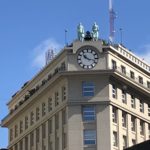 Two Buenos Aires images on my phone particularly strike me. On top of a large condominium, perhaps an office building, stand two Roman centurions, working men. When the hour strikes, they must clang a gong that lies below them, which may or may not still be functioning, and they must guard the building in case Huns or Goths or Uruguayans attack the city.
Two Buenos Aires images on my phone particularly strike me. On top of a large condominium, perhaps an office building, stand two Roman centurions, working men. When the hour strikes, they must clang a gong that lies below them, which may or may not still be functioning, and they must guard the building in case Huns or Goths or Uruguayans attack the city.
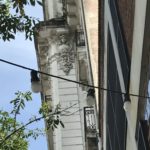
On the side of another small building, slightly weathered, crumbling just a bit, a face looks down at the street. Surrounded by swirling rococo lines and wearing some species of crown, it’s hard to imagine who she is (if even indeed she is a she) and what she represents. What was the relationship between the architect who designed the building – Argentina has a grand architectural tradition – and the sculptor who carved her design. What exchange occurred between the two? Add a face with a crown in that corner, throw in some embellishments. I wonder if there is a registry of these things somewhere in Buenos Aires, a catalogue of faces and figures on buildings. Borges comes to mind, of course.
*
The last stop is Bucharest, which I visited for the second time this summer, 2023. Both her communist era and early twentieth century splendor are strangely verklempt, melancholic.

One tall communist-era structure looks like an office building, though its homey curtains and flower pots suggest apartments. The structure is plain, nearly brutalist in design, but two solitary figures adorn the upper floors on either side. Both are partially nude, and both have androgynous faces though gender is suggested by the moustache and loin cloth on one and the conical breasts and sort of skirt or tunic on the other. The man carries what appears to be a hammer whereas the woman holds a small figure, a child, in her arms. The tiny size of the child suggests a newborn (a Madonna and child?) though the child’s features are those of a seven or eight year old. The Roman empire never quite stretched to Bucharest, but Roman architectural themes abound. These two figures seem like Roman gods or goddesses but which ones, I cannot say. They are like hieroglyphs before the Rosetta Stone, wrought in some lost language. My usual question comes to mind. What do the inhabitants of the drab building with the strange figures on top, the frequent passersby think of the child, the hammer, the expressionless faces.
The Roman acronym UGIR on a building nearby translates into English as a General Union of Industrialists in Romania. Despite its communist-era creation, it is for factory owners rather than workers. The description on their webpage is too literally translated to make such sense. “A national representative federation in its status, having as members, through the affiliated employer’s organizations, companies from all the activity areas and all the Romanian counties.” Romanian film directors, Cristian Mungiu and Crisi Puiu (poor Mr. Lazarescu) depict a country beset with corruption, which makes me wonder about the inner workings of UGIR.
But the figures in the six carvings on either side of the building may be innocent of what goes on inside. They fuse Bucharest’s classical fixation with socialist realism. In one panel, heroic figures, workers, hold a lamp, which inexplicably has a face inside it.
In the panel below, other workers who look Roman are placing a large bowl into an oven.
In another panel, two men wearing togas – Socrates, Plato – hold books in their hands. Which is fitting as they are in the only country that I’ve visited in which people come onto to trains to sell paperbacks. How do we read these figures? Are the industrialists in the building philosopher kings? Whoever commissioned or designed the structure was hardly limited by pure functionality. In fact, all the faces, the gods, the swirling Art Deco lines, the universe of architectural play in all these buildings in all these cities speak of aspirations, dreams, hopes, possibilities. They are the stuff of “there’s” rather than “no there’s”, of capitals rather than provinces.
